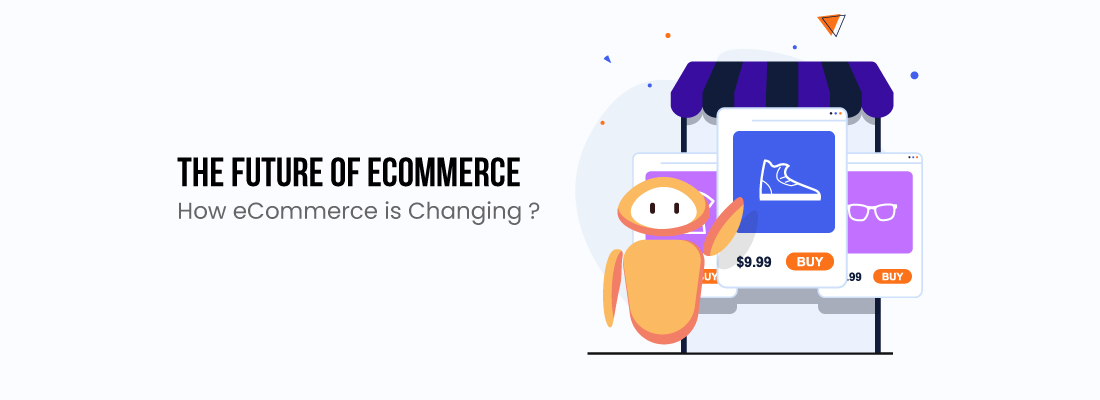The Future of eCommerce: How eCommerce Is Changing

As technology develops and our world becomes more connected, eCommerce is quickly altering to meet the changing needs of both consumers and businesses. Many variables influence the development of online purchasing, including the growth of mobile commerce, the importance of social media, and customization. The evolution of eCommerce, as well as the newest trends and innovations reshaping the sector, will be discussed in this article. Join us as we examine the fascinating advancements in eCommerce in more detail and discuss what they portend for the future of online buying.
7 ways how eCommerce is changing
Mobile Commerce:
M-commerce, often known as mobile commerce, is gaining popularity as more people use smartphones to access the internet. To accommodate mobile customers, retailers are making their websites mobile-friendly. Even more simplified and personalised shopping experiences are available thanks to the creation of specific mobile apps by some companies. Customers may now make purchases using their mobile devices more easily and conveniently thanks to the growth of new technologies like mobile wallets and payments.
Social Commerce:
As more individuals use smartphones to access the internet, mobile commerce, or m-commerce, is taking on greater significance. In order to serve mobile customers, retailers are optimising their websites. For a more streamlined and personalised shopping experience, several merchants have even developed specific smartphone apps. Customers may now purchase goods and services using their mobile devices with more ease and convenience thanks to the development of new technologies like mobile wallets and payments.
Personalization:
Data is being used by e-commerce merchants to tailor the purchasing experience for their customers. Customised suggestions based on prior purchases, targeted advertising, and personalised product search results are all examples of personalization. As customers seek more individualised and pertinent experiences, personalization is becoming more crucial for shops.
Artificial Intelligence:
By offering customised product recommendations, chatbots for customer support, and even virtual shopping assistants, AI is being utilised to enhance the shopping experience. AI is also being utilised to cut expenses and improve supply chain management. Retailers can, for instance, use AI-powered inventory management to make sure they have the proper quantity of merchandise on hand, lowering the risk of stockouts or overstocking.
Augmented Reality and Virtual Reality:
Customers can try on items, see how furniture looks in their homes, and engage more with things thanks to AR and VR technology, which improve the buying experience. Retailers selling things that customers want to view and experience before buying can benefit greatly from AR and VR technologies.
Subscription Services:
In e-commerce, subscription services are becoming more and more common since they give clients a convenient and reliable way to acquire goods on a regular basis. There are many different types of subscription services, from food packages to beauty items. Customers are drawn to subscription services because they provide convenience and cost savings while also giving shops a steady source of income.
Same-Day Delivery:
Delivery that is prompt and trustworthy has become essential to the success of online shopping. In order to satisfy customer needs for speedier shipping times, retailers are experimenting with new delivery techniques like drone deliveries and
same-day delivery. Same-day delivery is crucial for businesses that offer perishable items like groceries and flowers as well as for clients who require products right away.
Frequently Asked Questions
What are some of the key trends in eCommerce?
Mobile commerce, social commerce, customization, AI, augmented reality and virtual reality, subscription services, same-day delivery, and artificial intelligence are a few of the major developments in eCommerce.
How is mobile commerce changing eCommerce?
M-commerce, often known as mobile commerce, is growing more and more significant as more people use smartphones to access the internet. To accommodate mobile customers, retailers are making their websites mobile-friendly. Even more simplified and personalised shopping experiences are available thanks to the creation of specific mobile apps by some companies.
What is social commerce, and how is it changing eCommerce?
Social media can be used to promote an eCommerce site or to sell things directly through social media platforms. Social media sites like Facebook, Instagram, and Pinterest are quickly evolving into shopping destinations. Retailers' marketing and advertising strategies are evolving as a result of social commerce since they now need to concentrate on producing interesting content that appeals to social media users in order to generate sales.
Final thoughts
In conclusion, eCommerce is rapidly changing and expanding, and new technology and trends are always appearing. Personalised, practical, and quick shopping experiences that make use of the most recent technologies to satisfy customer needs will define the future of eCommerce. Mobile commerce, social commerce, customization, artificial intelligence, augmented reality and virtual reality, subscription services, and same-day delivery are important trends in eCommerce.
Retailers will need to follow these trends and keep innovating to satisfy the shifting needs of their customers as eCommerce expands and grows. Retailers may stand out in the
fiercely competitive eCommerce market by utilising the most recent technologies and offering individualised and convenient purchasing experiences. For more information, get in touch with Yugasa software Labs!
